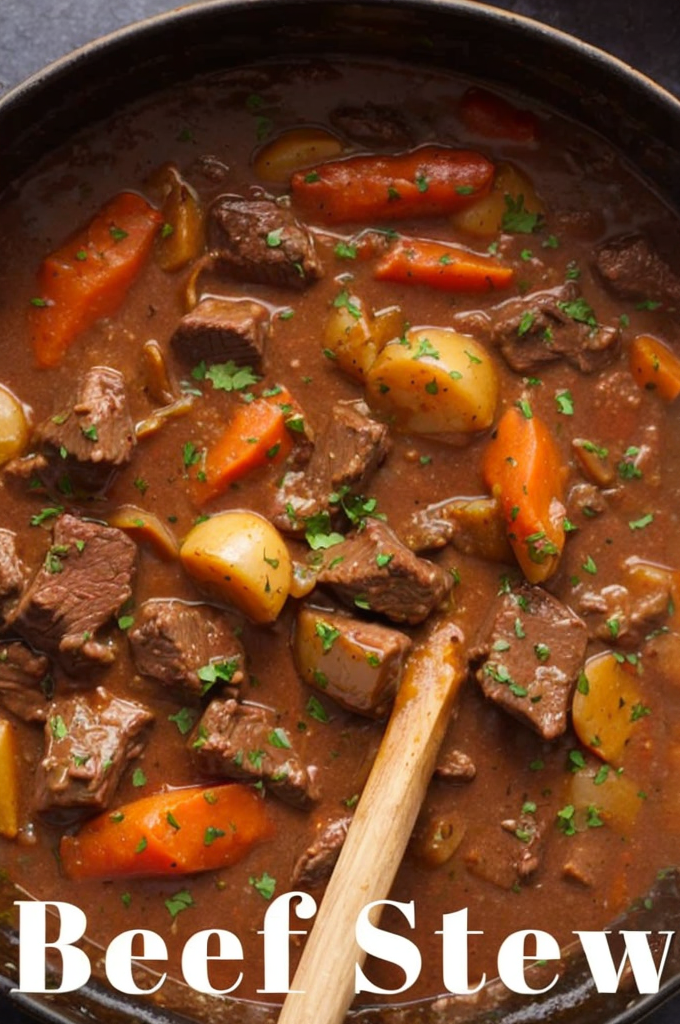Ultimate Guinness Beef Stew – Family Favorite Recipe
Ultimate Guinness Beef Stew – A Hearty Family Favorite
Discover the ultimate comfort food with our Ultimate Guinness Beef Stew. This family-favorite recipe combines tender chunks of beef, hearty vegetables, and the rich, savory depth of Guinness beer. The combination of flavors creates a soul-warming dish that’s perfect for chilly nights or special Sunday dinners. As the stew simmers, your kitchen fills with a tantalizing aroma that’s sure to bring everyone running to the table.
The beauty of this stew lies in its perfect balance of flavors. The Guinness beer adds a unique, slightly bitter richness that enhances the natural sweetness of the carrots and onions. This beef stew boasts a melt-in-your-mouth texture, achieved through a low and slow cooking process. The robust flavors create an unforgettable culinary experience that remains a staple in many households.
Quick Recipe Highlights
- Flavor Profile: This stew offers rich and savory notes with a touch of sweetness from carrots and onions, perfectly complemented by the bold taste of Guinness.
- Texture: The beef becomes fall-apart tender after slow cooking, while the vegetables maintain a delightful bite, providing a satisfying mouthfeel.
- Aroma: As it cooks, it releases a mouth-watering aroma of savory beef and earthy Guinness, mingled with the sweetness of onions and carrots.
- Visual Appeal: The final dish presents a rich, dark, and glossy stew filled with vibrant vegetables, delivering a comforting and rustic visual allure.
- Skill Level Needed: An intermediate level, as it requires browning meat, slow cooking, and balancing flavors.
- Special Equipment: A large Dutch oven or heavy-based pot to ensure even cooking.
Recipe Overview
- Difficulty Level: This recipe is rated as intermediate due to the need for proper browning of the beef and skillful simmering to achieve the desired texture.
- Category: Classified as a main dish, this stew is perfect for anyone seeking a hearty, filling meal option.
- Cuisine: Rooted in Irish culinary traditions, it features Guinness beer as a signature ingredient that highlights its cultural influence.
- Cost: Though it involves quality beef and beer, the recipe remains affordable. Most ingredients are pantry staples, keeping overall costs reasonable.
- Season: Best enjoyed during fall and winter when warming, hearty meals are a comforting escape from the cold.
- Occasion: Ideal for family dinners, gatherings, or St. Patrick’s Day celebrations, where classic flavors are cherished.
Why You’ll Love This Recipe
The taste and texture of Ultimate Guinness Beef Stew are unrivaled. The slow-cooked beef absorbs the flavors of the aromatic vegetables and Guinness, resulting in tender, juicy morsels. The complex flavors balance perfectly, ensuring each bite is a transition from savory to slightly sweet.
Convenience is key, and our stew excels in this area. Despite a longer cooking time, the prep work is straightforward, allowing you to attend to other tasks as it simmers. The slow cook enhances flavor integration, rewarding patience with mouthwatering results.
Nutritionally, this stew is a balanced meal. It provides valuable nutrients from the meat and vegetables, while the beer infusion offers antioxidants. It’s a dish that manages to be hearty and wholesome simultaneously.
Entertaining is a breeze with this stew, providing enough servings to satisfy a hungry crowd. Its comforting appeal makes it a frequent feature at celebrations or cozy dinners, bringing warmth and satisfaction to your guests.
Cost-effectiveness is built into the recipe. By utilizing in-season vegetables and economical cuts of beef, this dish remains budget-friendly without compromising flavor or quality.
Historical Background and Cultural Significance
The Guinness Beef Stew recipe has its origins in Ireland, where hearty stews have been a staple of the diet for centuries. The use of Guinness beer in cooking dates back to the 18th century when the beer became a national symbol of Ireland, revered not only as a beverage but also as an ingredient capable of enriching culinary creations.
Culturally, beef stew holds an iconic status. It’s a dish that embodies the warmth and community spirit found in Irish homes and pubs, often enjoyed alongside soda bread or mashed potatoes. This stew exemplifies the fusion of simple ingredients and skillful cooking techniques widespread in Irish cooking traditions.
Over time, the recipe evolved as it crossed borders. While authentically Irish at its core, regional variations have adapted it to include different vegetables or meats. Each adaptation infuses local culinary preferences, keeping the essence intact while allowing flexibility.
These days, the Guinness Beef Stew enjoys global recognition, celebrated as both a traditional Irish food and a versatile comfort dish. Whether in a pub in Dublin or a family home in New York, this dish transcends cultural boundaries, creating connections through flavor and tradition.
Ingredient Deep Dive
Beef, particularly chuck roast, is the star ingredient of this stew. Known for its marbling, chuck roast delivers the tenderness needed for slow-cooked dishes. It’s a significant part of many traditional Irish stews due to its ability to absorb and enhance the flavors of accompanying ingredients.
Nutrition-wise, beef provides a rich source of protein, iron, and essential vitamins, making it both satisfying and nourishing. When selecting beef, look for a good balance of marbling for flavor and texture, and aim for freshness by checking the use-by date and storing it in the coldest part of your fridge.
Guinness beer adds depth and complexity to the stew’s flavor profile. Its malty sweetness and dark, roasted tones become more pronounced as the alcohol cooks off, leaving a rich, earthy undertone that enhances the stew’s savory character.
When storing Guinness, keep it in a cool, dark place to maintain its flavor integrity. Should you need substitution, other dark beers, such as stouts or porters, can mimic its complexity, though the distinctive Guinness taste is unmatched.
Common Mistakes to Avoid
- Not browning the beef: Color equals flavor, so ensure every side of the beef is seared to a deep brown before simmering.
- Skipping the deglazing: Failing to scrape and deglaze the pot means losing flavors locked in the fond, which enriches the stew.
- Overfilling the pot: Overcrowding leads to steaming rather than browning, negatively impacting both texture and flavor development.
- Shortening cooking time: Rushing the process means tougher beef and less cohesive flavor integration, which is pivotal for this dish.
- Using too little seasoning: Remember to taste and adjust seasoning as the stew cooks, as the volume can mute flavors over time.
- Choosing too lean a cut of beef: Lean meat won’t yield the tenderness desired for stew, so choose cuts with marbling like chuck.
- Not skimming fat: Skim off excess fat that rises during cooking to prevent the stew from feeling greasy.
- Ignoring resting time: Letting the stew rest enhances its flavor, allowing it to meld and mellow as it sits, ensuring a richer taste.
Essential Techniques
Browning the meat is critical for developing the stew’s robust flavor. This process, known as the Maillard reaction, creates a rich, umami taste that’s the backbone of the stew. To master it, ensure the pan is hot and the beef is dry before searing, turning only when a deep crust forms.
Simmering is the key to achieving the stew’s renowned tenderness. Keeping the temperature low and steady ensures everything cooks uniformly without the beef becoming tough. Check occasionally, stirring to prevent sticking and maintain an even heat distribution.
Deglazing the pot with Guinness beer after browning extracts all the flavorful bits stuck at the bottom, incorporating them into the stew. Use a wooden spoon to gently scrape the surface as the beer simmers, dissolving the fond and embedding its richness into the dish.
Visual cues are essential for judging doneness. When the beef reaches fork-tenderness and the flavors are well integrated, you’re on the right track. Keep an eye on color and texture changes, and adjust seasoning at the end to suit your taste preferences.
Pro Tips for Perfect Ultimate Guinness Beef Stew
Use room temperature beef: Letting beef rest out of the fridge before browning ensures it sears rather than steams, producing better results.
For added depth, incorporate root vegetables like parsnips or turnips. They infuse earthy sweetness, enhancing the stew’s complexity.
Let the stew rest overnight. Many find the flavors develop and mature with time, enriching the dish after a day.
Before serving, add a splash of fresh Guinness to brighten the final flavor and contrast with the stew’s slow-cooked richness.
Experiment with herbs like thyme or a bay leaf. They contribute an aromatic quality that elevates the overall taste profile.
Don’t skip the proper seasoning. Layering salt and pepper at each flavorful junction ensures an end product that sings.
Ensure even vegetable cuts. Uniform pieces lead to consistent cooking, preventing some bits from becoming mushy while others remain underdone.
Variations and Adaptations
Regional variations abound, with some adding potatoes directly into the stew for a heartier version, commonly seen in various Western Ireland adaptations. This offers extra starchiness and makes for a more filling dish.
When adapting this stew for different seasons, consider swapping out carrots for parsnips in the autumn, imparting a gentle sweetness that pairs well with the rich sauce.
For dietary modifications, consider substituting gluten-free flour when browning beef or thickening to cater to gluten sensitivity with minimal impact on texture or taste.
Alternatively, explore different flavor combinations by integrating a couple of tablespoons of tomato paste while deglazing. This adds an umami punch, perfectly balancing the beer’s bitterness.
To modify the stew’s texture, chop vegetables more finely for a smoother, integrated mouthfeel or leave them chunkier for a rustic presentation.
Presentation alternatives offer creativity. Serve over mashed potatoes or within a bread bowl to enhance its comfort appeal, adding a unique touch to your table.
Serving and Presentation Guide
Plating this stew is an opportunity to highlight its rich colors. Use a wide, shallow bowl to showcase the deep hues of the sauce against the vibrant vegetables, drawing the eye in.
Garnishing with freshly chopped parsley not only adds a pop of color but a touch of freshness that complements the dish’s depth. A dollop of crème fraîche atop each bowl provides contrast and creaminess, blending beautifully with the stew’s warm tones.
Serve alongside classic accompaniments such as a crusty loaf of bread to soak up the flavorful gravy, or opt for a lighter side like a simple green salad, balancing the richness of the stew.
For a modern take, consider serving with garlic-mashed potatoes, their creaminess playing off the stew’s bold flavors, completing your plate with sophistication.
Maintain temperature considerations in mind; serve piping hot, preferably in pre-warmed bowls, to enhance flavors and warmth on a cool evening.
Portion control helps manage servings and balance caloric intake. A hearty stew easily satisfies, so measure servings to approximately 1-1.5 cups per person, ensuring satisfaction without overindulgence.
Wine and Beverage Pairing
When considering wine pairings, a full-bodied red like a Cabernet Sauvignon complements the deep, hearty profile of the stew. The tannins present in the wine enhance the richness of the beef and the stew’s overall flavors.
For non-alcoholic alternatives, a dark cranberry or blackcurrant juice offers an appealing balance of sweet and tart, harmonizing beautifully with the savory depth of the dish.
Coffee or strong black tea with dessert rounds out the meal, providing a refreshing contrast and cleansing the palate after the dense, rich flavors of the stew.
As temperature is key, red wines are best served slightly cooler than room temperature to prevent overpowering the stew, while chilled juices refresh and reset the palate.
Serving suggestions vary: consider a small wine glass to savor, or a larger goblet for juices to enhance aromas and drinking experience, elevating the meal’s overall sophistication.
Storage and Shelf Life
Storing leftover stew involves cooling it completely before transferring it into airtight containers. Doing so maintains freshness and prevents exposure to bacteria.
Refrigerate for up to three days, keeping it at a consistent cold temperature below 40°F to ensure its safety and quality remain intact. For extended storage, freezing is ideal. Divide the stew into portions and freeze in airtight bags or containers, labeled with the date.
To reheat, allow frozen stew to thaw in the refrigerator overnight before gently warming on the stove over low heat, stirring occasionally to prevent sticking. Add a splash of broth or water if it thickens too much during storage.
Signs of spoilage include off smells, changes in texture, or mold. If these are present, it’s best to discard for safety. Pay attention to the recommended storage times to avoid these issues.
Remember, freezing is best within the first two days to lock in the stew’s flavor and texture, ensuring it tastes just as good upon reheating.
Make Ahead Strategies
Plan using a prep timeline, engaging in vegetable chopping and beef trimming a day ahead, saving stress on cooking day. This gives you ample time to focus on flavor building.
Store components separately if preparing in stages; keep the seared beef and sliced vegetables typically double wrapped in the fridge to keep them fresh and prevent cross-contamination.
Before final assembly, ensure elements are at room temperature to guarantee even reheating without shock chilling the cooking pot, which could extend cooking times unnecessarily.
Flavor assessments indicate stew benefits from melding overnight. Store fully cooked stew in the fridge, reheating gently to preserve its slow-simmered taste and texture.
Consider adding fresh elements like herbs or a squeeze of citrus upon reheating to perk up flavors rehydrated during storage, creating a light and fresh feel despite being made ahead.
Scaling Instructions
Scaling down by halving the recipe suits smaller families or less storage space, maintaining all cooking techniques and ingredient ratios to retain the balance of flavors.
Conversely, doubling or tripling requires appropriate equipment to accommodate increased volume, such as switching to larger pots or adjusting oven racks.
Timing modifications for larger batches include extended browning times to ensure all pieces are consistently cooked, avoiding overcrowding that could lead to steaming over searing.
When considering storage, remember scaled-up recipes demand more containers and potentially more fridge or freezer space, keeping freshness and food safety at the forefront.
Nutritional Deep Dive
The nutritional makeup of our stew merges protein-rich beef with nutrient-dense vegetables, offering a macro breakdown of balanced carbohydrates, fats, and protein.
Vitamins like B12 from the beef and vitamin C from the veg contribute positively to overall health, lending immunity support and energy production benefits.
Health benefits extend to circulation and muscle health from the iron content in the beef, alongside the beer’s modest contribution of essential antioxidants and stress relief.
Portion analysis respects a generous single serving, approximately 400-500 calories, aligning well with dietary goals mindful of balance and satisfaction in one delicious setting.
Mindful portions coupled with healthy sides contribute to weight management, providing an indulgent feel while supporting nutritional balance and well-being.
Dietary Adaptations
For those with gluten sensitivity, substitute traditional flour used in browning with gluten-free alternatives like rice flour, maintaining texture and flavor.
A dairy-free version can easily be adapted by avoiding butter, relying on oils, or broth for flavor enhancement, ensuring it remains rich yet suitable for lactose intolerant individuals.
For a vegan twist, substitute beef with hearty mushrooms, like portobello, and use vegetable stock, creating a plant-based adaptation celebrating the same rich Guinness notes.
Consider a low-carb approach by reducing or eliminating root vegetables like carrots, bulking up with additional proteins or greens to cut down on carbs without diminishing flavor.
Keto adaptations might involve using high-fat beef and incorporating additional fats elsewhere to meet keto macros while replacing starchy vegetables with low-carb options.
Paleo dieters can remove beer, switching to bone broth or red wine vinegar for acidity, focusing on clean components yielding a tasteful yet compliant dish.
A low-FODMAP version might minimize onions and garlic, opting for specific spices or herbs that introduce robust flavors typically restricted under this diet approach.
The Recipe
Ultimate Guinness Beef Stew
Serves: 6
Prep Time: 30 mins
Cook Time: 180 mins
Total Time: 210 mins
Kitchen Equipment Needed
- Large Dutch oven or heavy-based pot
- Wooden spoon
- Sharp knife
- Cutting board
Ingredients
- 2 lbs beef chuck roast, cut into cubes
- Salt and pepper to taste
- 3 tablespoons all-purpose flour
- 3 tablespoons olive oil
- 1 large onion, chopped
- 3 cloves garlic, minced
- 2 cups carrots, sliced
- 2 cups beef broth
- 2 cups Guinness beer
- 2 tablespoons tomato paste
- 1 teaspoon dried thyme
- 2 bay leaves
- Chopped parsley for garnish
Directions
- Season beef with salt and pepper, then coat lightly with flour.
- Heat olive oil in a Dutch oven over medium-high heat. Brown beef in batches, ensuring all sides are seared. Remove and set aside.
- Add onion and garlic to the pot; sauté until fragrant. Stir in carrots and continue to cook for 3-4 minutes.
- Pour in Guinness to deglaze, scraping up any browned bits from the bottom of the pot.
- Add beef broth, tomato paste, thyme, bay leaves, and return beef to the pot. Bring to a boil, then lower heat to simmer.
- Cover and cook for 2.5 to 3 hours until beef is tender and flavors meld. Stir occasionally.
- Remove bay leaves, adjust seasoning, and garnish with parsley before serving.
Recipe Notes
- For a thicker stew, remove the lid during the last 30 minutes of cooking.
- Opt for Yukon gold potatoes for more bulk and texture if desired.
- Substitute dark beer brands if Guinness isn’t available.
Troubleshooting Guide
Texture issues may arise if the stew’s consistency is too thick or thin. To adjust, add broth for thinning or simmer uncovered longer for thickening, ensuring balance is regained.
Flavor balance can shift, so check seasoning levels regularly, particularly salt and acidity, recalibrating where needed to enhance the dish’s profile.
Temperature problems, such as overcooking beef, can be mitigated by maintaining a consistent low heat. Use a thermometer if necessary to avoid extremes.
Equipment challenges could be managed by ensuring correct pot size for volume or heating methods, possibly transferring to the oven for equal heat distribution.
Ingredient substitutions should focus on keeping integrity; using equivalent weight and flavor where possible, and adjusting cooking times accordingly.
Timing concerns such as starting late mean options like increasing temperature slightly may expedite cooking but with caution to not compromise tenderness.
Recipe Success Stories
Community feedback has raved about the Ultimate Guinness Beef Stew, praising its depth of flavor and ease of preparation. Many have shared variations like adding potatoes or mushrooms for extra heartiness.
Adapting based on local ingredients has proven successful, with readers swapping different beers or adding Gruyère toasts for added richness.
Suggestions poured in for pairing ideas: several found serving the stew with a side of Guinness bread amplifies the flavors beautifully.
Photography tips highlighted include capturing the rich hues of the stew under natural light, accentuating its rustic appeal alongside garnished elements like parsley or thyme.
Reader stories often mention how this recipe has transformed into a cherished family classic, with modifications shared across generations, turning each bowl into a testament of culinary tradition.
Frequently Asked Questions
Can I use other types of beer?
Yes, you can experiment with other stouts or porters. Each will impart a slightly different flavor profile, so adjust seasonings as necessary.
What can I use instead of Guinness for a non-alcoholic version?
Swap with beef or vegetable broth for a similar liquid volume, though you’ll miss out on the unique Guinness depth. Adjust herbs and seasoning to emulate complexity.
Can freeze leftovers?
Absolutely; ensure they cool completely before transferring to airtight containers. They’re good up to three months, ideal for convenient meals later.
How do I store the stew?
Refrigerate any leftovers in airtight containers once cooled, maintaining freshness for up to three days. Reheat gently to preserve texture and flavor.
Are there substitute herbs for thyme and bay leaves?
Replace with rosemary for thyme’s earthiness or basil for a refreshing tweak. These modify the aromatic profile subtly yet enticingly.
What goes well with this stew?
Serve with crusty bread, mashed potatoes, or a light salad to complement the rich, hearty flavors, allowing the stew to remain the star.
Can I make this stew without a heavy-bottom pot?
If unavailable, use the next thickest pot. However, adjust cooking times and monitor to prevent uneven cooking and sticking bottom issues.
Why do I need to brown the meat?
Browning amplifies flavor through caramelization, developing a savory depth essential to stew’s rich profile, embedded into the overall taste.
Is it okay to use pre-cut stew meat?
While convenient, check meat quality and cut sizes. Chuck roast allows customization of size for better control over texture outcomes.
Does this stew have a strong beer taste?
While the beer imparts depth, it melds with other ingredients to create a balanced, complex flavor that doesn’t overpower the dish.
Additional Resources
Explore related recipes featuring classic Irish meals like Colcannon or Shepherd’s Pie, integrating similar ingredients for extended culinary adventures.
Technique guides such as proper browning methods or slow-cooking fundamentals offer insights critical for achieving stew excellence, heightening cooking prowess.
Ingredient information on cuts of beef or variety in Guinness brews provides a spectrum of knowledge enhancing selection decisions crucial for taste success.
Equipment recommendations span beyond just pots, highlighting useful tools like slow cookers for simplified stew prep or immersion blenders for texture adjustments.
Seasonal variations invite exploration, adapting lighter ingredients in spring or richer bases come winter, ensuring this stew’s versatility across yearly rotations.
Join the Conversation
Engage with us on social media, sharing your ultimate stew photos using #GuinnessStewCreations and become part of our culinary family while inspiring others.
Consider photography tips found here to elevate your dish presentation, capturing everything from ingredient prep to the tantalizing finished product.
Leave your recipe reviews and personal twists below, an invitation to collective experimentation, sparking dialogue and innovation within our community.
Engage with us beyond the recipe; join cooking groups, attend workshops focused on stew-making, embracing the camaraderie of like-minded food lovers.
Share recipe variations or successful adaptations with us, contributing to our growing resource pool, cultivating creativity and expanding culinary horizons.






